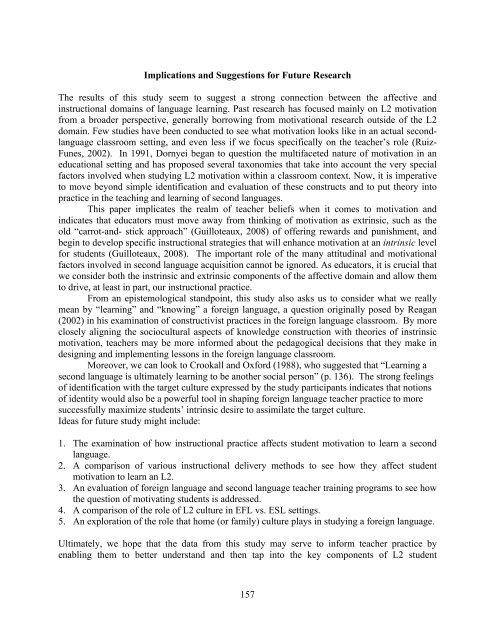Journal of Research in Innovative Teaching - National University
Journal of Research in Innovative Teaching - National University
Journal of Research in Innovative Teaching - National University
Create successful ePaper yourself
Turn your PDF publications into a flip-book with our unique Google optimized e-Paper software.
Implications and Suggestions for Future <strong>Research</strong><br />
The results <strong>of</strong> this study seem to suggest a strong connection between the affective and<br />
<strong>in</strong>structional doma<strong>in</strong>s <strong>of</strong> language learn<strong>in</strong>g. Past research has focused ma<strong>in</strong>ly on L2 motivation<br />
from a broader perspective, generally borrow<strong>in</strong>g from motivational research outside <strong>of</strong> the L2<br />
doma<strong>in</strong>. Few studies have been conducted to see what motivation looks like <strong>in</strong> an actual secondlanguage<br />
classroom sett<strong>in</strong>g, and even less if we focus specifically on the teacher’s role (Ruiz-<br />
Funes, 2002). In 1991, Dornyei began to question the multifaceted nature <strong>of</strong> motivation <strong>in</strong> an<br />
educational sett<strong>in</strong>g and has proposed several taxonomies that take <strong>in</strong>to account the very special<br />
factors <strong>in</strong>volved when study<strong>in</strong>g L2 motivation with<strong>in</strong> a classroom context. Now, it is imperative<br />
to move beyond simple identification and evaluation <strong>of</strong> these constructs and to put theory <strong>in</strong>to<br />
practice <strong>in</strong> the teach<strong>in</strong>g and learn<strong>in</strong>g <strong>of</strong> second languages.<br />
This paper implicates the realm <strong>of</strong> teacher beliefs when it comes to motivation and<br />
<strong>in</strong>dicates that educators must move away from th<strong>in</strong>k<strong>in</strong>g <strong>of</strong> motivation as extr<strong>in</strong>sic, such as the<br />
old “carrot-and- stick approach” (Guilloteaux, 2008) <strong>of</strong> <strong>of</strong>fer<strong>in</strong>g rewards and punishment, and<br />
beg<strong>in</strong> to develop specific <strong>in</strong>structional strategies that will enhance motivation at an <strong>in</strong>tr<strong>in</strong>sic level<br />
for students (Guilloteaux, 2008). The important role <strong>of</strong> the many attitud<strong>in</strong>al and motivational<br />
factors <strong>in</strong>volved <strong>in</strong> second language acquisition cannot be ignored. As educators, it is crucial that<br />
we consider both the <strong>in</strong>str<strong>in</strong>sic and extr<strong>in</strong>sic components <strong>of</strong> the affective doma<strong>in</strong> and allow them<br />
to drive, at least <strong>in</strong> part, our <strong>in</strong>structional practice.<br />
From an epistemological standpo<strong>in</strong>t, this study also asks us to consider what we really<br />
mean by “learn<strong>in</strong>g” and “know<strong>in</strong>g” a foreign language, a question orig<strong>in</strong>ally posed by Reagan<br />
(2002) <strong>in</strong> his exam<strong>in</strong>ation <strong>of</strong> constructivist practices <strong>in</strong> the foreign language classroom. By more<br />
closely align<strong>in</strong>g the sociocultural aspects <strong>of</strong> knowledge construction with theories <strong>of</strong> <strong>in</strong>str<strong>in</strong>sic<br />
motivation, teachers may be more <strong>in</strong>formed about the pedagogical decisions that they make <strong>in</strong><br />
design<strong>in</strong>g and implement<strong>in</strong>g lessons <strong>in</strong> the foreign language classroom.<br />
Moreover, we can look to Crookall and Oxford (1988), who suggested that “Learn<strong>in</strong>g a<br />
second language is ultimately learn<strong>in</strong>g to be another social person” (p. 136). The strong feel<strong>in</strong>gs<br />
<strong>of</strong> identification with the target culture expressed by the study participants <strong>in</strong>dicates that notions<br />
<strong>of</strong> identity would also be a powerful tool <strong>in</strong> shap<strong>in</strong>g foreign language teacher practice to more<br />
successfully maximize students’ <strong>in</strong>tr<strong>in</strong>sic desire to assimilate the target culture.<br />
Ideas for future study might <strong>in</strong>clude:<br />
1. The exam<strong>in</strong>ation <strong>of</strong> how <strong>in</strong>structional practice affects student motivation to learn a second<br />
language.<br />
2. A comparison <strong>of</strong> various <strong>in</strong>structional delivery methods to see how they affect student<br />
motivation to learn an L2.<br />
3. An evaluation <strong>of</strong> foreign language and second language teacher tra<strong>in</strong><strong>in</strong>g programs to see how<br />
the question <strong>of</strong> motivat<strong>in</strong>g students is addressed.<br />
4. A comparison <strong>of</strong> the role <strong>of</strong> L2 culture <strong>in</strong> EFL vs. ESL sett<strong>in</strong>gs.<br />
5. An exploration <strong>of</strong> the role that home (or family) culture plays <strong>in</strong> study<strong>in</strong>g a foreign language.<br />
Ultimately, we hope that the data from this study may serve to <strong>in</strong>form teacher practice by<br />
enabl<strong>in</strong>g them to better understand and then tap <strong>in</strong>to the key components <strong>of</strong> L2 student<br />
157

















